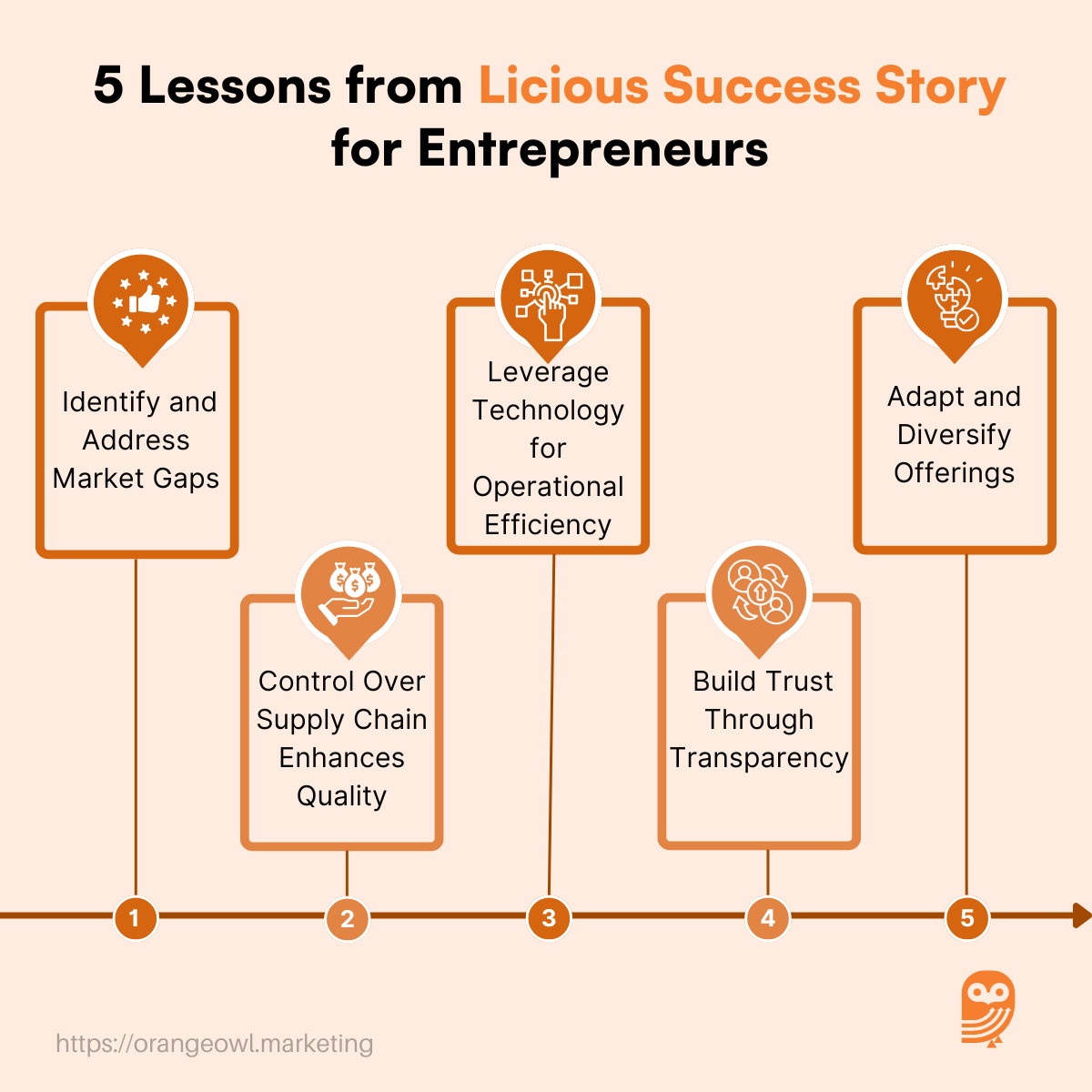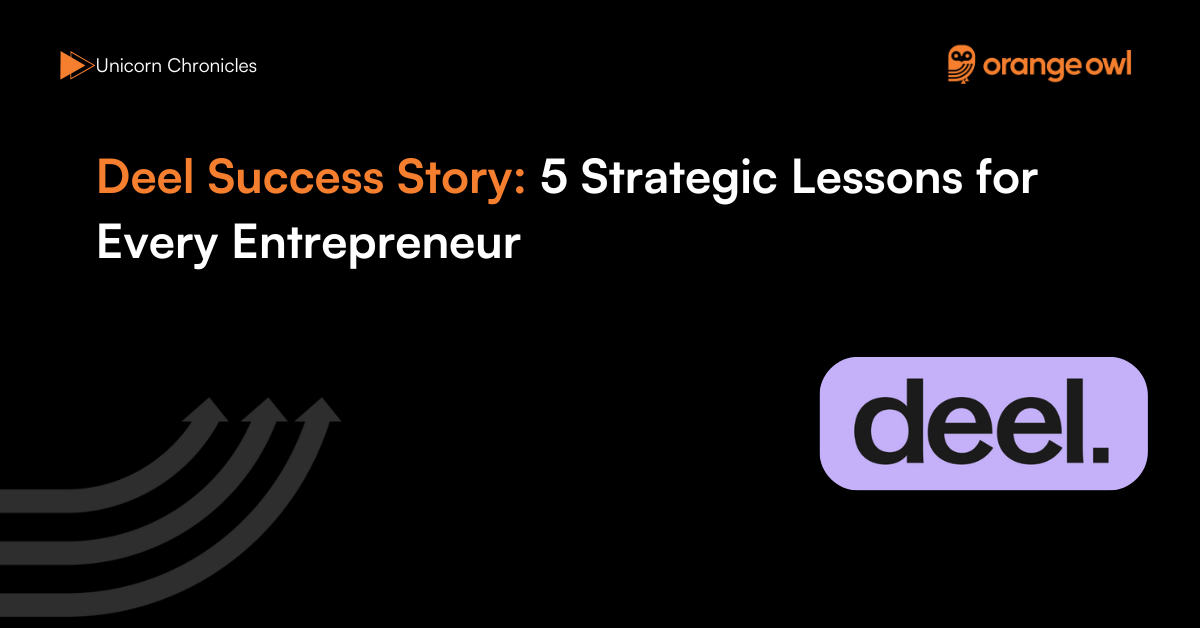Licious Success Story: 5 Growth Lessons Every Entrepreneur Should Learn
Vivek Goel
June 17, 2025

Table of Contents
Introduction
In India’s rapidly evolving food-tech landscape, Licious has emerged as a trailblazer, revolutionizing the meat and seafood industry. Founded in 2015 by Abhay Hanjura and Vivek Gupta, Licious set out to address a significant gap in the market: the lack of quality, hygienic, and trustworthy meat products. Over the years, the company has transformed from a startup into a unicorn, setting new standards in the sector and offering valuable lessons for entrepreneurs.
Licious’s journey from inception to becoming a unicorn has been marked by strategic decisions and a focus on quality and customer experience. In October 2021, the company achieved a significant milestone by raising $52 million from IIFL Asset Management Ltd’s private equity fund, propelling its valuation to over $1 billion and making it the first direct-to-consumer startup in India to attain unicorn status.
Financially, Licious has demonstrated resilience and adaptability. In the fiscal year 2022-23 (FY23), the company reported an operating revenue of ₹747.7 crore, marking a 9.6% increase from the previous year. Despite this growth, the company faced challenges in meeting its projected revenue of ₹1,500 crore. However, it managed to narrow its losses to ₹528.5 crore from ₹855.6 crore in FY22, reflecting improved operational efficiency.
The following fiscal year, FY24, presented new challenges. Licious’s revenue dipped by 8% to ₹685 crore, primarily due to the closure of third-party distribution channels like Dunzo and Swiggy Meatstore, and a strategic shift away from modern trade and local stores. Nevertheless, the company achieved a 44% reduction in net losses, bringing them down to ₹294 crore. This improvement was attributed to cost control measures and a focus on owned channels, including the company’s app, which accounted for 85% of its business.
Licious’s commitment to innovation and customer satisfaction is evident in its initiatives like the “Infinity” loyalty program, which contributes 58% of its overall revenue, and the pilot of 30-minute deliveries in Gurugram. The company also plans to expand its physical retail presence, aiming to open 500 offline stores in key markets over the next few years.
Origin Story
The idea behind Licious was born not from a boardroom but from a shared frustration between two friends—Abhay Hanjura and Vivek Gupta—who were passionate meat lovers. Tired of the unreliable quality, questionable hygiene, and inconsistent service from local meat vendors in India, the duo saw an opportunity in a space that was long overlooked.
Abhay, who had a background in biotechnology, and Vivek, a finance professional, decided to leave behind their well-established careers to take on what many considered an unconventional and risky venture—redefining the way Indians buy and consume meat.
“We asked ourselves—why is it that the most-loved food item in India is being treated like a stepchild in the retail ecosystem?” Vivek Gupta recalled.
In 2015, Licious was launched with a bold mission: to deliver fresh, high-quality, and hygienically processed meat and seafood to Indian households. What set them apart wasn’t just their product, but the level of control they exerted over every part of the supply chain—right from sourcing to last-mile delivery.
Business Landscape and Early Challenges
Entering the Indian meat and seafood market meant stepping into one of the most fragmented, unorganized, and underserved segments of the food industry. With over 90% of the sector operating informally, there were barely any standardized practices, and quality control was nearly non-existent. For Licious, this meant that creating a trustworthy brand would require a complete reinvention of the supply chain.
“We knew that if we wanted to deliver quality consistently, we couldn’t depend on existing systems—we had to build our own,” said Abhay Hanjura.
Licious adopted a farm-to-fork model, taking full ownership of procurement, processing, cold storage, and logistics. The company built dedicated meat processing centers compliant with global food safety standards, introduced vacuum-sealed packaging, and implemented a cold chain system that maintains temperatures below 4°C throughout—a first in India’s meat industry.
The startup faced skepticism from both consumers and investors. Educating consumers in a price-sensitive market about the value of premium, hygienic meat was a tough sell initially. Convincing suppliers to adhere to stringent quality protocols was equally challenging. Additionally, since buying meat was predominantly an offline habit, Licious had to drive a behavioral shift toward online meat purchases.
Despite the uphill climb, their strategy paid off. “We believed that if we could solve this right, we could create a category that never existed before,” Vivek explained.
Over the years, this relentless focus on quality, control, and consumer trust allowed Licious to turn a traditional, underserved market into one of the most rapidly growing segments of Indian food-tech.
Growth Strategies
Licious’s meteoric rise in India’s food-tech space is a result of bold, strategic decisions that prioritized quality, innovation, and scalability. At the core of its strategy was complete control over the end-to-end supply chain. Unlike traditional retailers who rely on third-party vendors, Licious took ownership of every step—from sourcing directly from farms to processing, packaging, and last-mile delivery. This vertical integration allowed the company to maintain strict hygiene protocols, ensure freshness, and offer consistent quality—factors that helped build unprecedented trust in a sector plagued by irregular standards.
Another cornerstone of Licious’s growth was its deep integration of technology. The company implemented advanced systems for inventory management, real-time demand forecasting, and intelligent routing for logistics. These tools not only optimized operations but also enabled the company to scale rapidly without compromising on the consumer experience. “We’re not a meat company that uses tech. We are a tech-enabled meat brand,” Vivek Gupta noted in an interview, underscoring the role of digital infrastructure in their growth playbook.
Recognizing the evolving preferences of India’s urban population, Licious strategically diversified its product portfolio. What started with fresh meat and seafood quickly evolved to include ready-to-cook marinated products, heat-and-eat meals, and even spice blends. This allowed the company to cater to time-starved millennials and health-conscious consumers who seek convenience without compromising on quality.
Geographic expansion was also executed thoughtfully. Beginning in Bengaluru, the brand expanded across 28 Indian cities by 2023, including Delhi NCR, Mumbai, Chennai, Hyderabad, and Kolkata. Licious localized its supply chain in each new market to maintain freshness, while tapping into region-specific culinary habits. This city-by-city rollout helped the company maintain control while growing at a sustainable pace. According to a report by YourStory, Licious recorded a 70% increase in annual revenue in FY23, touching ₹700 crore (~$85 million) as a result of these strategies.
Marketing Strategies
Licious’s marketing strategy played a pivotal role in transforming consumer perception in a traditionally informal market. One of their key marketing pillars was radical transparency. They created behind-the-scenes content that showcased their meat processing facilities, cold-chain logistics, and hygiene standards—helping address long-standing consumer skepticism around cleanliness and safety. This openness reassured customers that Licious wasn’t just another meat seller, but a brand with global-quality practices and serious commitment to health and hygiene.
Another smart move was premium brand positioning. Instead of competing on price, Licious framed itself as a gourmet, lifestyle-driven brand. Their branding emphasized indulgence, culinary exploration, and “meatlicious” experiences, effectively distancing themselves from local butchers and commoditized frozen meat vendors. Campaigns like “Quality you can trust, taste you’ll love” reinforced this premium image.
Customer engagement was also central to their marketing success. Licious invested in building a strong relationship with its users through personalized communications, in-app feedback loops, and hyper-responsive customer service. User suggestions often shaped product development and marketing creatives, creating a feedback-driven brand experience. “We treat every customer as if they’re our first,” said Abhay Hanjura, highlighting the customer-first culture embedded in the brand’s DNA.
Through a combination of trust-building narratives, elevated brand identity, and consistent consumer interactions, Licious managed to turn meat-buying—an offline chore—into an online lifestyle experience.
5 Insightful Lessons Every Entrepreneur Should Learn from Licious
1. Identify and Address Market Gaps
Licious’s founding was driven by a deep understanding of a clear market inefficiency: the lack of hygienic, high-quality, and reliable meat in India’s urban areas. Abhay Hanjura and Vivek Gupta were not the first to sell meat—but they were the first to offer it in a branded, premium, and trustworthy way at scale. This ability to see what was missing and deliver a compelling solution gave them an early mover advantage. For entrepreneurs, the takeaway is simple but profound: real opportunity often lies in unorganized or overlooked sectors. By identifying pain points in daily consumer experiences and solving them thoughtfully, entrepreneurs can create lasting impact and build defensible businesses.
“If we could solve for trust in meat—something people consume and feed their families—we knew we’d build a brand people would return to,”- Vivek Gupta
2. Control Over Supply Chain Enhances Quality
One of Licious’s boldest and most effective decisions was to take ownership of its entire supply chain—from sourcing and processing to packaging and delivery. This vertical integration gave them unmatched control over product quality, freshness, and safety. While expensive and complex, it allowed them to set their own standards instead of relying on inconsistent third-party vendors.
This lesson applies across industries: when quality is non-negotiable, owning the critical parts of the value chain can differentiate a brand. For entrepreneurs building consumer-facing products—especially in food, health, or personal care—investing in the supply chain can be the foundation of long-term trust and brand equity.
“We couldn’t afford to leave hygiene to chance. That’s why we decided to build everything ourselves,” said Abhay Hanjura.

3. Leverage Technology for Operational Efficiency
Licious didn’t just rely on traditional retail models—it infused technology into every layer of its operations. From real-time inventory tracking and cold chain logistics to demand forecasting and customer data analytics, the company used digital tools to streamline processes and reduce waste. This helped them deliver fresh products daily in multiple cities while keeping unit economics in check.
For modern entrepreneurs, this is a key takeaway: technology is no longer just a backend tool—it’s a scalable enabler. Whether it’s a small startup or a growth-stage company, tech can unlock automation, insights, and personalization that create a competitive edge.
“Technology has helped us not just scale but also humanize the customer experience,” Vivek noted in an interview.
4. Build Trust Through Transparency
In India, meat buying has traditionally been shrouded in ambiguity. Licious flipped this narrative by openly showcasing its sourcing standards, hygiene protocols, and cold-chain processes through advertising, website videos, and even facility tours. This transparency didn’t just inform consumers—it reassured them.
Trust is the cornerstone of any successful consumer brand, especially in categories involving health and safety. Entrepreneurs should remember that transparency creates confidence, and when customers believe in your process, they become loyal advocates.
“We invited customers to see where their food came from—and that honesty created belief,” said Abhay.
5. Adapt and Diversify Offerings
Licious’s evolution from fresh cuts of meat to ready-to-cook, ready-to-eat meals, and spice blends wasn’t just smart—it was essential. They understood that urban customers wanted convenience, taste, and speed. By offering marinated kebabs, biryanis, and pre-cooked delicacies, Licious expanded its share of the consumer’s kitchen and increased average order values.
Entrepreneurs must always keep a pulse on changing consumer preferences. Diversification—when rooted in customer insight—can help businesses grow without losing focus. It also insulates companies from market saturation in their original category.
“We’re not just selling meat—we’re selling moments of indulgence and ease in your everyday life,” Vivek Gupta explained.
Conclusion
The Licious success story is more than a case of a startup disrupting a traditional industry—it’s a blueprint for how to build a consumer brand in modern India. By identifying a genuine gap, owning the supply chain, leveraging tech, and building trust through radical transparency, Licious has redefined what quality means in the meat and seafood space.
The founders’ relentless focus on customer experience and strategic adaptability has taken the company from a Bengaluru-based startup to a unicorn valued at over $1 billion. As Abhay and Vivek gear up for the next phase—scaling operations, entering new verticals, and possibly going public—entrepreneurs across sectors can draw rich inspiration from their journey.
“We didn’t want to build a meat company. We wanted to build a brand that India could be proud of.”- Abhay


